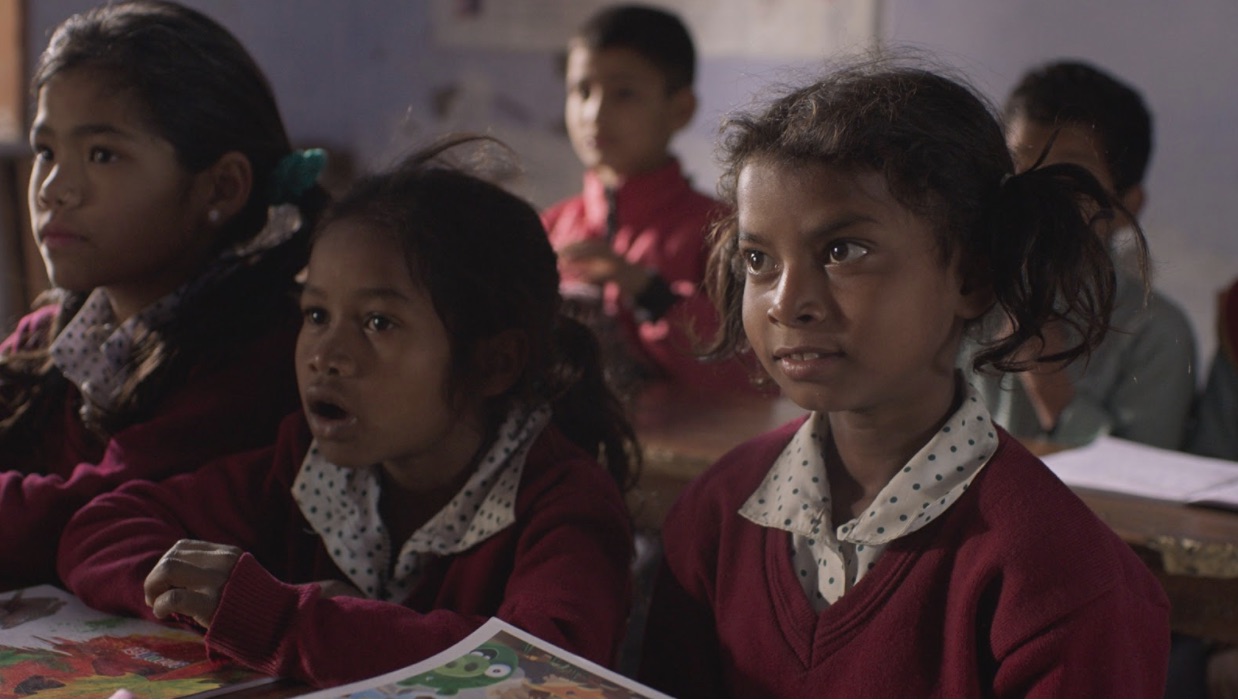In 2013, at least 23 school children in the Indian state of Bihar died after their lunch meals were unintentionally contaminated with pesticides. At the time, filmmaker Karishma Dev Dube, a native of New Delhi, was in the nascent days of her studies at NYU Tisch’s Graduate Film program. While the Bihar tragedy was not the first of its kind, the incident reverberated globally and led to widespread news coverage, government changes to the school lunch programs in India, and criminal negligence charges against the school’s principal. The story also burrowed deep into the mind of Dube and emerged years later as the short film Bittu, a Student Academy Award winner set to be awarded gold, silver, or bronze at a virtual ceremony on October 21.
Bittu is Dube’s attempt to reconcile an unspeakable loss caused by negligence, but not outright malice. And so she trains her lens on the dissenting and beguiling student Bittu, whose friendship with the more conforming Chand makes for a dynamic interplay. Where Chand is an overachiever, Bittu is a lone wolf who will get things done her way. Dube centers this conflict in the film’s crucial scene, presenting a startling realization about the merits of Bittu’s individualism.
The following conversation with Karishma Dev Dube has been condensed and edited for clarity.
Can you describe the effect the tragedy in Bihar had on you and how it led you to this film?
Around the end of 2014, beginning of 2015, I wanted to make this my second year film—it never quite worked on paper for a long time. There was a lot of footage of the local community afterward, so there was a lot of material that stuck with me. I kind of put it aside and got back into it after. I spent about two and a half years trying to find the right version of the script. To me, it started working a lot more when I realized I had to contain it within a relationship—it had to be about the people that it happened to. My [approach] to the film was the friendship between [Bittu and Chand]; it felt like it was starting to get somewhere once I made it about the love in that relationship.
It was very important for me to tell the story without necessarily painting anyone as the villain. It was important for me not to indict anyone in the story, but I didn’t want to spare anyone of any responsibility, either. It took a while to find a version where it felt like I was stressing on the fact that it was an accidental thing that happened, but at the same time making a story about the place and how being cut off and in the middle of the mountains was a big factor in the tragedy being so bad.
If I’m completely honest, I don’t know what kept driving me back to the script. I just felt like I had to get it out of me.
What were you looking for in terms of a shooting location?
We shot the film in a small town in the foothills of the Himalayas. I wanted the kids to have a relationship with the place where I was going to shoot it. You can really tell that some of them live on the mountain. I wanted the two girls to have a strong relationship because I knew I didn’t have the money or time to build a relationship between two girls who may have not known each other before. I locked the location, and I was pretty familiar with it because I went to school there when I was younger.
Bittu’s and Chanda’s contrasting personalities make for a captivating back-and-forth. What did the casting process look like for these two young girls?
The whole film includes first-time performers, besides the male teacher who is an actor from Mumbai. I was very sure when I was writing the film that it was going to be really hard to do this with a child actor who is professionally trained, especially in India. It wouldn’t fit with the type of film I was making in terms of tone.
I never knew what I was looking for [in terms of actors]. It was not as simple as me just having an open call for auditions and kids just coming to me. I had to look for them in different schools. The first round was going and visiting all the government schools around, and I didn’t really find anyone there. My friend and I started going to introduce ourselves to different communities around the location. This was the first day we actually did that, when we found Rani [Kumari], the girl who plays Bittu. She was a little different visually, but we had an instant connection. She came running out of the village and wanted to play—she was a bit of a leader and got all the kids together. I started going back to the same place every day, and every time I went back I was more sure that she was the kid… She liked being a performer, she wasn’t scared of the attention.
Once I was sure of Bittu, I started looking for Chand in the same community. I found Renu [Kumari] pretty quickly. I started working with them and teaching them lines every day. We talked a lot about the characters so they could make a distinction between what’s fiction and what's real life. We had to spend time playing games and creating memories that I could reference back to on set. On set, it would be like, “Remember when you spoke to that guy like this? I want you to talk to him like that.” It was more of a reference system.
Even within the short runtime, we discover that Bittu is this layered, mercurial child. It’s easy to chalk her antics up to youthful mischief because we’re ultimately reminded of her compassion. What made you choose to explore this character more so than the others?
The protagonist was alive in my head for a very long time. In India, there’s so much stress on discipline and the formality of authority, instead of time spent actually teaching life values. I wanted to make a film about a kid who was a bit unaware of traditional norms and would question everything… I had a feeling that I wanted her to be saved by her own individuality.
It sounds simple, but I didn’t want to make a depressing film about a really tragic event.

